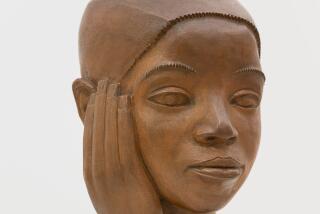Cultural Reawakening Born of Debris
While the debris still smoldered, a handful of black artists returned to Watts after the riot of 1965 and spent hours riffling through the rubble like scavengers.
Powerful artworks resulted.
“They picked up the pieces, pieces of history, and incorporated them into their work to make statements on political and social issues that affected Afro-American life in Southern California and the rest of the nation,” says Lizzetta LeFalle-Collins, curator of an exhibit that includes works born of that turbulent era.
“19 Sixties, A Cultural Awakening Re-Evaluated, 1965-1975,” at the California Afro-American Museum through Sept. 10, focuses on how the era influenced black art in Los Angeles. Using photomurals depicting signs of the volatile time--the Watts riot, Vietnam War protests and Black Panther co-founder Huey P. Newton--it features works by nine local artists responding in large part to the call of an emerging black nationalism.
“This was an important time in the development of Afro-American artists, definitely one of the high points for Southern California, right up there with the Harlem Renaissance,” said LeFalle-Collins, the museum’s curator of visual art.
Assemblage, paintings and sculpture by Noah Purifoy, John Outterbridge, Betye Saar, Alonzo Davis, David Hammons, Suzanne Jackson, John Riddle, Timothy Washington and Charles White make up the 77-piece exhibit.
“All of them were making a comment on Afro-American culture and experience in the U.S., all of them spoke of the inequities (endured by blacks), all of them really pulled from their Afro-American folk culture, their every day experiences in their families and communities,” she said.
Like those who mined the charred detritus of Watts, all but two of these artists worked mostly with found objects. There’s Riddle’s “The Ghetto Merchant,” made of a cash register from a burned-out store in Watts, Saar’s “Little Black Sambo” with a devilish black doll wielding rifles, and other fetish-like works made with discarded rags, twine or human hair.
Several factors contributed to the artists’ preference for assemblage, the curator said.
“Many of them figured they were outside of the mainstream art world and they were going to use materials they felt were outside of traditional ways of expressing oneself with paint, canvas and sculptural media.”
In addition, they were looking back to their roots in the early South where the folk tradition of giving new life to discarded materials flourished, she said.
“Traditional quilters still use discarded clothing remnants. People took rags and made them into rag dolls.”
An examination of the artists’ earlier roots was also at play.
“A lot of traditional African sculptors used many of the materials, nails, beads or bits of mirror for example, used in the exhibit’s fetish-like works. The whole idea of assemblage was extremely important to these artists.”
SHOW AND TELL: About 60 artists will invite the public into their downtown studios Saturday and Sunday for the 1989 Open Studio Tours organized by Los Angeles Contemporary Exhibitions (LACE). The artists, all LACE members working in a variety of media, will be present for discussion and demonstrations. The tours are self-directed, with maps provided by LACE. Saturday’s route will include studios north of 7th Street and Sunday’s circuit will take in those south of 7th Street. Both journeys begin at noon and end at 5 p.m. Tickets and maps are $6, or $4 for LACE members, and will be available at LACE, 1804 Industrial St., on the day of each tour for that day only. There will be no advance sales. Information: (213) 624-5650.
KUDOS: Culver City-based photographer Jo Ann Callis is one of 10 artists nationwide to be named a winner of the Eighth Annual Awards in the Visual Arts. Callis will receive $15,000 and will be included in a traveling exhibition of works by all 10 winners. The show will stop off at the La Jolla Museum of Contemporary Art Aug. 19 to Oct. 15. The museum, as the other three on the exhibit’s route, will be given $10,000 to purchase work for its permanent collection by one or more the award program’s winners. The program was founded and is administered by the Southeastern Center for Contemporary Art in Winston-Salem, N. Carolina. Information: (919) 725-1904.
More to Read
The biggest entertainment stories
Get our big stories about Hollywood, film, television, music, arts, culture and more right in your inbox as soon as they publish.
You may occasionally receive promotional content from the Los Angeles Times.










